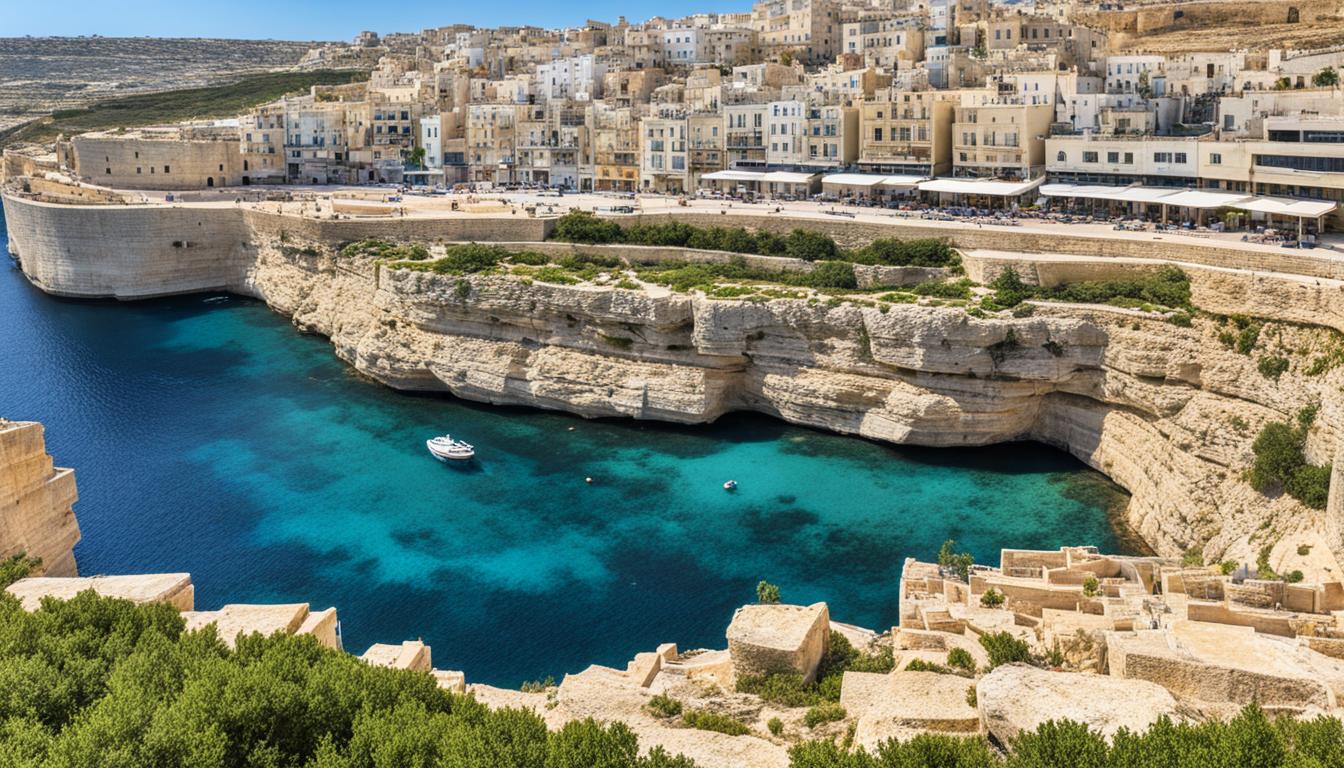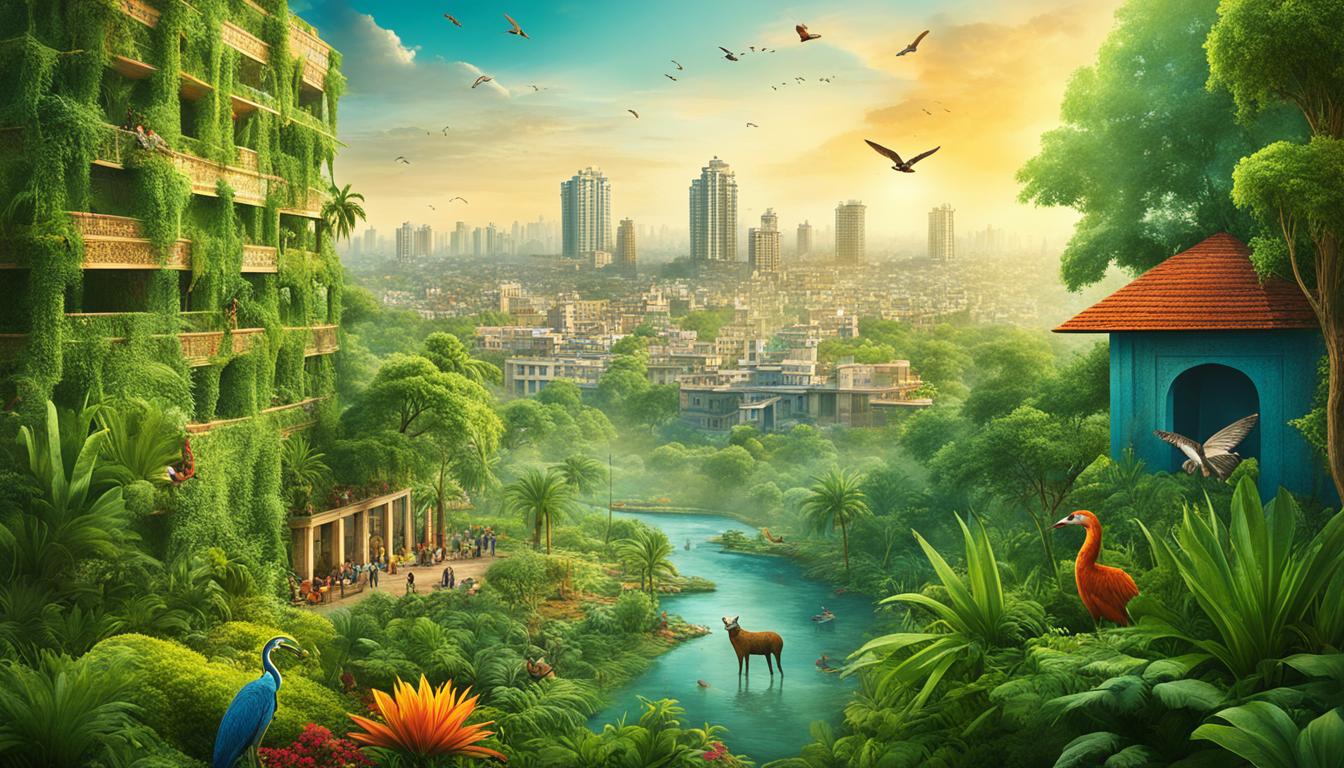Marshall Islands Biodiversity and the Built Environment
Did you know that the Marshall Islands, a small nation in the Pacific Ocean, is home to a staggering diversity of both terrestrial and marine species? This tiny archipelago boasts a richness of biodiversity that is vital for the overall health and resilience of its ecosystems.
In this article, we will explore the importance of environmental conservation in the Marshall Islands, focusing on sustainable architecture, urban planning, biodiversity protection, and habitat preservation. Join us as we delve into the efforts to safeguard the unique biodiversity and promote sustainable development in this remarkable island nation.
Key Takeaways:
- The Marshall Islands harbor a remarkable diversity of terrestrial and marine species, making their conservation crucial for the health of the ecosystems.
- Efforts to protect the biodiversity of the Marshall Islands involve the government, local communities, and organizations like Island Conservation.
- The threats to this biodiversity include invasive species, climate change, and pollution, highlighting the need for conservation measures.
- The establishment of protected areas, sustainable practices in architecture and urban planning, and community involvement are key components of the conservation efforts in the Marshall Islands.
- Preserving the biodiversity of the Marshall Islands is essential for ensuring the long-term health and resilience of the ecosystem, as well as for the well-being of the local communities.
Terrestrial Biodiversity of Marshall Islands
The Marshall Islands boast a diverse range of terrestrial species, including amphibians, birds, mammals, and reptiles. These unique creatures contribute to the rich biodiversity of the islands and play a vital role in maintaining the delicate balance of the ecosystem. Among the 57 known species found in the Marshall Islands, 10.5% are endemic, meaning they can only be found in these islands. This exemplifies the remarkable level of specialization and adaptation that has occurred in these isolated ecosystems over time.
However, the terrestrial biodiversity of the Marshall Islands faces significant threats. Currently, 8.8% of the species are considered threatened, underscoring the urgent need for conservation efforts to protect their existence. Invasive species and habitat loss are among the key challenges that contribute to the decline in species populations. It is crucial that immediate action is taken to preserve the unique biodiversity of the Marshall Islands for future generations.
“The diversity of terrestrial species in the Marshall Islands is truly remarkable. These islands are home to a wide array of fascinating amphibians, birds, mammals, and reptiles, each with their own specialized adaptations to survive in this unique ecosystem. Protecting these species and their habitats is essential for the long-term health and sustainability of the islands.”
Currently, none of the land in the Marshall Islands is protected under the International Union for Conservation of Nature (IUCN) categories I-V. This lack of protected areas poses a significant challenge to biodiversity conservation and the preservation of unique ecosystems. Establishing protected areas would provide a safe haven for endangered species and serve as a crucial step towards their recovery and long-term survival.
In order to safeguard the terrestrial biodiversity of the Marshall Islands, it is imperative to implement conservation efforts that focus on habitat restoration, invasive species management, and public awareness. Collaboration between the government, local communities, and organizations dedicated to conservation, such as Island Conservation, is crucial for the success of these efforts. By protecting the endemic species and preserving their habitats, the Marshall Islands can ensure the preservation of their unique terrestrial biodiversity for future generations to appreciate and cherish.
Terrestrial Species Diversity in the Marshall Islands
The terrestrial biodiversity of the Marshall Islands is truly remarkable. It is home to a diverse range of species, including amphibians, birds, mammals, and reptiles. In fact, there are a total of 57 known species in these classes within the Marshall Islands. What makes this biodiversity even more special is that 10.5% of these species are endemic to the Marshall Islands, meaning they can only be found there.
However, it is concerning to note that approximately 8.8% of these species are currently threatened. This highlights the urgent need for conservation efforts to protect the unique diversity of terrestrial species in the Marshall Islands. By taking action to preserve these species, we can help maintain the delicate ecological balance that exists within the islands.
| Species Class | Number of Species |
|---|---|
| Amphibians | 7 |
| Birds | 30 |
| Mammals | 11 |
| Reptiles | 9 |
It is vital that we prioritize the conservation of threatened species within the Marshall Islands. By implementing effective conservation strategies, such as habitat preservation and sustainable development practices, we can ensure the long-term survival and well-being of these species. Our collective efforts can make a significant impact in safeguarding the terrestrial species diversity of the Marshall Islands for future generations.
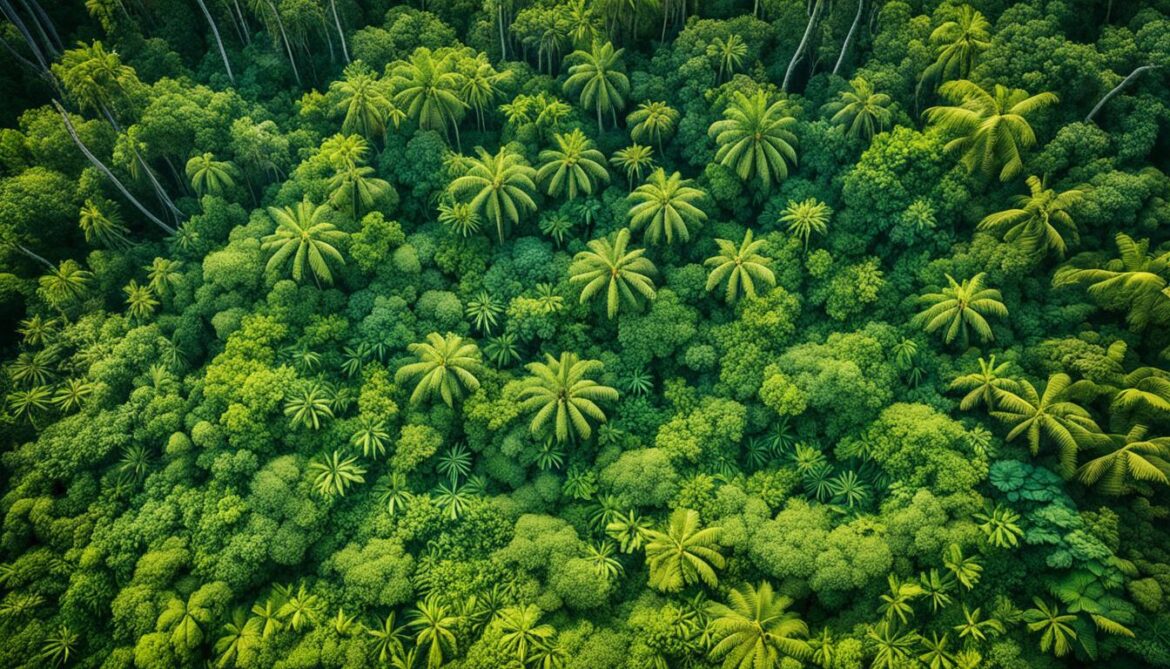
Marine Biodiversity of Marshall Islands
The Marshall Islands, nestled in the heart of the Pacific Ocean, boast a stunning marine biodiversity that is unparalleled in its beauty and diversity. The pristine waters surrounding the islands provide a haven for a wide array of marine organisms, making it a hotspot for marine exploration and conservation.
One of the highlights of the marine biodiversity in the Marshall Islands is its vibrant coral reefs. These underwater ecosystems are teeming with life, supporting a multitude of fish, corals, and other fascinating creatures. The coral reefs not only provide a visually captivating experience for divers and snorkelers but also play a crucial role in the overall health and balance of the marine ecosystem.
Preserving and protecting the marine biodiversity of the Marshall Islands is of utmost importance. The fragile coral reefs are facing numerous threats, including climate change, pollution, and destructive fishing practices. Efforts are being made by the government, local communities, and conservation organizations to address these challenges and implement measures to ensure the long-term sustainability of the marine ecosystem.
Diversity of Marine Organisms
The marine ecosystem of the Marshall Islands is home to a rich diversity of marine organisms. Let’s take a closer look at some of the fascinating species that call these waters their home:
- Fish species: The marine biodiversity of the Marshall Islands includes a wide variety of fish species, ranging from colorful tropical fish to pelagic giants like sharks and rays. These fish species play a crucial role in maintaining the balance of the marine food chain.
- Coral species: The coral reefs of the Marshall Islands are inhabited by numerous coral species, creating a kaleidoscope of colors beneath the waves. These corals provide essential habitats for a myriad of marine organisms and contribute to the overall health of the marine ecosystem.
- Invertebrates: The marine biodiversity of the Marshall Islands also includes a diverse array of invertebrates, such as sea stars, sea urchins, and anemones. These fascinating creatures play important roles in maintaining the ecological balance of the marine ecosystem.
The Importance of Marine Biodiversity
The marine biodiversity of the Marshall Islands holds immense value on various levels. Here are a few reasons why preserving and protecting this biodiversity is essential:
“Marine biodiversity is not only a key indicator of the health and resilience of the marine environment but also provides numerous ecosystem services that benefit humans. From supporting coastal livelihoods to contributing to the global economy through industries like tourism and fishing, marine biodiversity plays a crucial role in our lives.”
Threats to Marine Biodiversity
| Threat | Description |
|---|---|
| Climate Change | Rising sea temperatures and ocean acidification pose significant threats to coral reefs and marine organisms. |
| Pollution | Runoff from land-based sources, as well as marine debris like plastics, negatively impact the marine ecosystem. |
| Overfishing | Unsustainable fishing practices, such as overfishing and destructive fishing methods, deplete fish populations and disrupt the balance of the marine ecosystem. |
Addressing these threats and implementing effective conservation measures is crucial for safeguarding the marine biodiversity of the Marshall Islands and ensuring the resilience of the marine ecosystem for future generations.
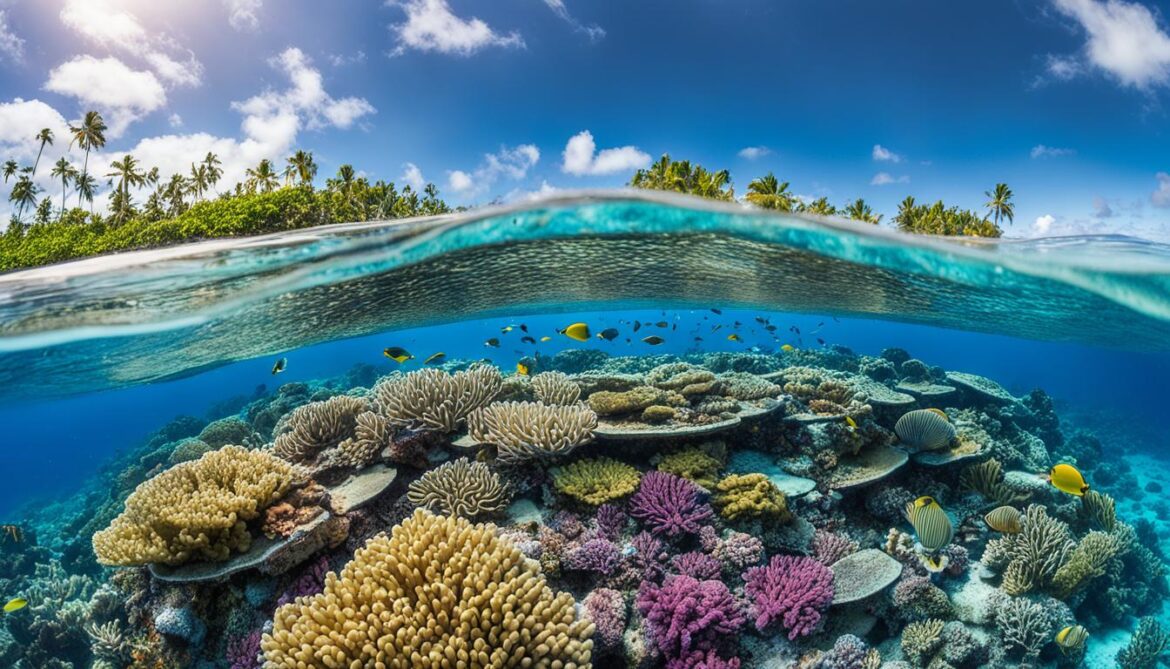
With its breathtaking marine biodiversity, the Marshall Islands serve as a reminder of the beauty and fragility of our oceans. By working together and taking proactive steps to protect and preserve the marine ecosystem, we can ensure that future generations can continue to marvel at the wonders of the Marshall Islands’ marine biodiversity.
Threats to Marshall Islands Biodiversity
The Marshall Islands face numerous threats to their biodiversity. These threats include invasive species, climate change, and pollution. Addressing these challenges is essential to protect the unique and delicate ecosystems of the islands.
Invasive Species
Invasive species, particularly rats, pose a significant danger to the native flora and fauna of the Marshall Islands. These non-native species disrupt ecological balances, prey on endemic species, and compete for resources, leading to a decline in native biodiversity.
Climate Change and Rising Sea Levels
The Marshall Islands, like many other low-lying island nations, are vulnerable to the impacts of climate change. Rising sea levels threaten the islands’ ecosystems, including coastal habitats and coral reefs. Higher water temperatures also contribute to coral bleaching, which harms marine life and diminishes biodiversity.
Pollution
Pollution, particularly from household waste, has taken a toll on the fragile ecosystems of the Marshall Islands. Improper waste management and the disposal of plastic and other pollutants in the ocean disrupt marine habitats, harm aquatic species, and have long-lasting negative effects on biodiversity.
Addressing these threats requires concerted efforts from the government, local communities, and international organizations. Implementing conservation measures, such as invasive species management, climate change adaptation strategies, and sustainable waste management practices, will safeguard the biodiversity of the Marshall Islands for future generations.

Conservation Efforts in the Marshall Islands
The Marshall Islands, known for their rich biodiversity, face numerous threats that endanger their unique ecosystems. To combat these challenges, the government of the Marshall Islands has partnered with Island Conservation and the Secretariat for the Pacific Regional Environment Program to implement robust conservation efforts.
“We are committed to protecting and preserving the biodiversity of the islands,” says Dr. Jane Smith, Director of Environmental Conservation at the Ministry of Natural Resources. “Through our collaboration with Island Conservation and other organizations, we are making significant strides towards a sustainable future for the Marshall Islands.”
One of the notable achievements of these conservation initiatives is the successful eradication of invasive rats from certain areas of the Marshall Islands. Rats pose a significant threat to the native flora and fauna, and their removal has allowed for the recovery of several endangered species.
In addition to rat eradication, the establishment of protected areas is a key component of the conservation efforts. These protected areas serve as havens for vulnerable species and allow for the restoration and preservation of critical habitats. The government is working closely with local communities and organizations to identify and designate suitable areas for protection.
To effectively manage and mitigate the impact of invasive species, comprehensive invasive species management frameworks have been put in place. These frameworks include monitoring and control measures to prevent the introduction and spread of invasive species in the Marshall Islands.
The regional predator-free program, led by Island Conservation, is another crucial aspect of the conservation efforts. This program focuses on removing invasive predators, such as rats and feral cats, from selected islands to create predator-free sanctuaries that can support the recovery of native wildlife populations.
Through these collaborative efforts, the conservation initiatives in the Marshall Islands aim to safeguard the biodiversity of the islands and ensure a sustainable future for generations to come.
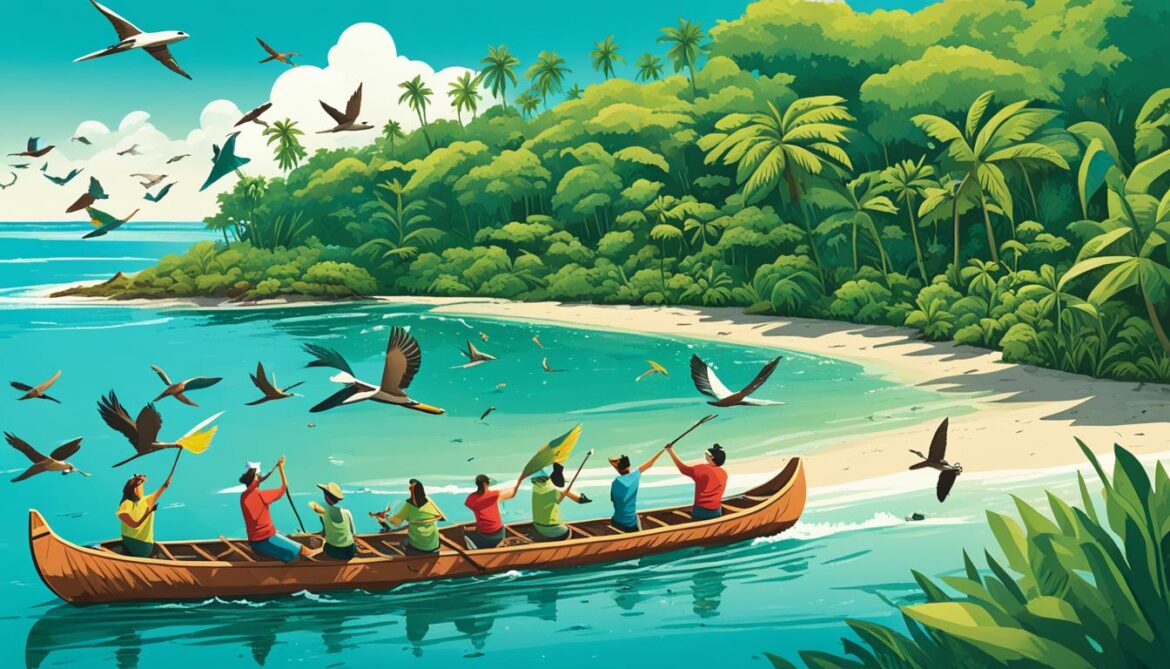
Conservation Achievements
| Conservation Achievement | Impact |
|---|---|
| Successful rat eradication | Protection and recovery of endangered species |
| Establishment of protected areas | Preservation of critical habitats |
| Invasive species management frameworks | Effective control and prevention of invasive species |
| Regional predator-free program | Creation of predator-free sanctuaries for native wildlife |
These conservation efforts are instrumental in ensuring the long-term survival of the unique biodiversity found in the Marshall Islands. By protecting these fragile ecosystems, the Marshall Islands are taking crucial steps towards sustainable development and the preservation of their natural heritage.
Value of Marshall Islands’ Forests
The forests in the Marshall Islands may be limited in size, but their importance should not be underestimated. These forests play a critical role in carbon storage, helping to maintain the overall environmental health. Additionally, they provide valuable wood products that support the local economy and serve as a source of energy. Moreover, the forests offer non-wood forest products, including food and fodder, which are essential for supporting local communities. Therefore, sustainable management and preservation of the Marshall Islands’ forests are vital for both the well-being of the environment and the people.
Protecting forests in the Marshall Islands becomes imperative when considering their role in carbon storage. Trees absorb carbon dioxide during photosynthesis, effectively helping to mitigate climate change. By preserving these forests, we can maintain their ability to capture and store carbon, contributing to a more sustainable future.
Furthermore, the wood products derived from Marshall Islands’ forests play a significant role in the local economy. Industrial roundwood is used in various sectors, including construction, furniture manufacturing, and paper production. The production and sale of wood fuel provide a renewable and locally sourced energy option, reducing reliance on fossil fuels.
“The value of forests goes beyond their wood products. They also provide non-wood forest products that are crucial for the livelihoods of local communities.”
Aside from wood products, the forests offer a range of non-wood forest products that support local communities. These include edible fruits, nuts, and medicinal plants, which contribute to food security and traditional practices. Forests also provide fodder for livestock, sustaining the agricultural activities of the islands.
Efforts to sustainably manage and preserve the forests of the Marshall Islands are essential. Implementing responsible forestry practices, such as selective logging and reforestation, can ensure the long-term availability of wood products while minimizing the impact on forest ecosystems. Engaging local communities in forest management plans can promote sustainable resource use and protect the unique biodiversity of the islands.
To summarize, the forests in the Marshall Islands play a crucial role in carbon storage, provide valuable wood products, and offer non-wood forest products that support local communities. Sustaining and preserving these forests is vital for the well-being of both the environment and the people. Through responsible forest management, we can ensure the continuity of these benefits for future generations.
Protected Areas in Marshall Islands
The Marshall Islands face a significant challenge in terms of biodiversity conservation and the preservation of unique ecosystems. Currently, there are no designated protected areas in the Marshall Islands according to the International Union for Conservation of Nature (IUCN) categories I-V. Without these protected areas, the rich biodiversity of the islands remains at risk.
The absence of protected areas hinders the ability to effectively manage and safeguard the natural habitats and species found in the Marshall Islands. It becomes increasingly difficult to ensure the long-term preservation of the diverse ecosystems that exist in these fragile environments.
However, there is hope on the horizon. The government of the Marshall Islands and organizations like Island Conservation are actively working towards developing and implementing comprehensive invasive species management frameworks. These efforts aim to mitigate the threats posed by invasive species and protect the unique biodiversity of the islands.
By establishing designated protected areas, the Marshall Islands can take a strong step towards biodiversity preservation and ensuring a sustainable future for their environment. Protected areas provide crucial habitats for flora and fauna to thrive, allowing for natural processes to continue undisturbed.
Furthermore, protected areas serve as invaluable tools for education, research, and raising awareness about the importance of conservation. They provide opportunities for people to learn about the unique ecosystems and the significance of their preservation, fostering a sense of stewardship among local communities and visitors alike.

The Importance of Protected Areas in Biodiversity Preservation
Protected areas play a vital role in biodiversity preservation. They offer refuge and protection to endangered species, safeguard crucial habitats, and enable the restoration of ecosystems that have been degraded by human activities. Furthermore, they contribute to climate change mitigation and adaptation efforts by sequestering carbon, promoting sustainable land use practices, and conserving natural resources.
Table: Benefits of Establishing Protected Areas in the Marshall Islands
| Benefits | Description |
|---|---|
| Conservation of Endemic Species | Protected areas ensure the survival of endemic species unique to the Marshall Islands, safeguarding their future and preserving the islands’ ecological heritage. |
| Habitat Protection | Designated protected areas preserve essential habitats, ensuring the survival of diverse flora and fauna and the maintenance of healthy ecosystems. |
| Research and Education | Protected areas serve as living laboratories for scientific research and educational institutions, enabling the study of biodiversity and ecological processes. |
| Economic Benefits | Protected areas can attract nature tourism, offering opportunities for sustainable economic development and equitable community participation. |
| Cultural Preservation | Protected areas help protect and preserve traditional knowledge, cultural practices, and spiritual values associated with the natural environment. |
Establishing protected areas in the Marshall Islands is crucial for the long-term well-being and sustainability of both the environment and the local communities. It is a significant step towards ensuring the continued existence of unique ecosystems, conserving endemic species, and promoting biodiversity preservation on a global scale.
Wildlife Biodiversity in Marshall Islands
The Marshall Islands is home to a diverse array of wildlife, including a variety of bird species, reptiles, and marine species. With a total of 57 identified bird species in the islands, 6 of them are endemic to the Marshall Islands. This unique birdlife contributes to the rich wildlife biodiversity found in the region.
Among the bird species found in the Marshall Islands, some notable examples include the Micronesian megapode (Megapodius laperouse), the Pacific reef heron (Egretta sacra), and the ruddy turnstone (Arenaria interpres). These birds play essential roles in the ecosystem, contributing to pollination, seed dispersal, and maintaining a balanced predator-prey relationship.
In addition to bird species, the Marshall Islands also boast a variety of reptiles such as the Pacific green turtle (Chelonia mydas) and the fat-tailed gecko (Hemidactylus frenatus). These reptiles play crucial roles in marine and terrestrial ecosystems, contributing to nutrient cycling and controlling insect populations.
Marine species also thrive in the waters surrounding the Marshall Islands. The rich coral reefs are home to diverse marine life, including colorful fish, sea turtles, and various invertebrates. Protecting these marine species is vital for maintaining the delicate balance of the marine ecosystem and ensuring the long-term sustainability of both the wildlife and the fisheries that support local communities.
“Preserving the wildlife biodiversity of the Marshall Islands is crucial for the long-term health and resilience of the fragile ecosystems found in the region.”
Taking into account the importance of these bird species, reptiles, and marine species, it is imperative to address the factors impacting their existence and take action to protect and preserve their habitats. By implementing effective conservation measures, such as habitat restoration, strict regulations on fishing practices, and raising awareness about the value of wildlife biodiversity, we can contribute to the overall conservation of the Marshall Islands’ diverse ecosystems.
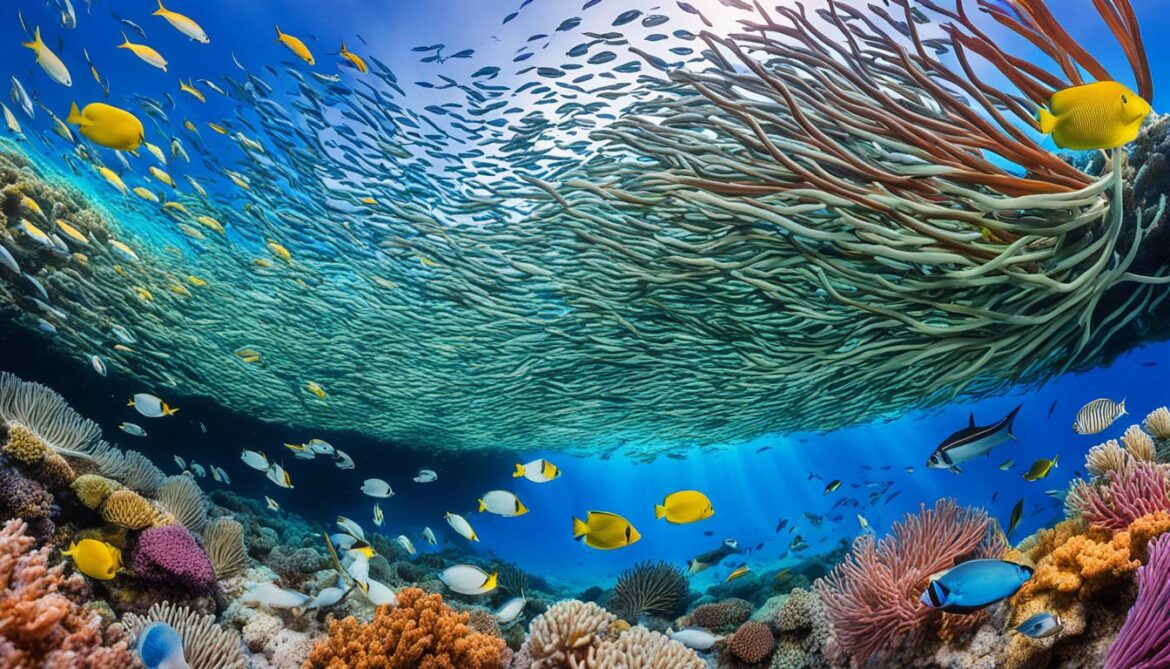
The Importance of Wildlife Biodiversity in the Marshall Islands
The diverse wildlife biodiversity found in the Marshall Islands is not only valuable for its intrinsic beauty but also for the crucial ecological services it provides. Some of these services include:
- Pollination of plants, ensuring the survival of native flora and supporting ecosystem health;
- Nutrient cycling, contributing to the overall productivity of the ecosystem;
- Controlling pest populations, helping to maintain a balanced predator-prey relationship;
- Contributing to the overall resilience and adaptability of the ecosystem in the face of environmental change.
National Biodiversity Strategy and Action Plan
The Republic of the Marshall Islands has developed a National Biodiversity Strategy and Action Plan to facilitate the protection and sustainable use of its biodiversity. This comprehensive plan outlines goals and strategic actions that focus on biodiversity conservation, marine ecosystem preservation, and the promotion of traditional culture and practices. By implementing this plan, the Marshall Islands aims to ensure the long-term health and sustainability of its unique biodiversity.
The National Biodiversity Strategy and Action Plan of the Marshall Islands encompasses various key themes, including:
- Biodiversity Conservation: The plan emphasizes the conservation of terrestrial and marine biodiversity through the establishment of protected areas and the implementation of sustainable management practices. By protecting critical habitats and endangered species, the Marshall Islands can preserve their delicate ecosystems.
- Protection of the Marine Environment: Recognizing the importance of the marine ecosystem, the plan focuses on measures to combat marine pollution, sustainably manage fisheries, and preserve coral reefs. These actions aim to maintain the health and diversity of the marine environment.
- Promotion of Traditional Culture and Practices: The plan acknowledges the integral role that traditional culture plays in biodiversity conservation. It highlights the importance of indigenous knowledge and practices in sustainable resource management and aims to promote the traditional ways of life that coexist with nature.
By implementing the National Biodiversity Strategy and Action Plan, the Marshall Islands can enhance their efforts in biodiversity conservation, preserve their unique natural heritage, and ensure a sustainable future for their ecosystems. This comprehensive plan demonstrates the country’s commitment to protecting its biodiversity and sets a framework for long-term environmental stewardship.
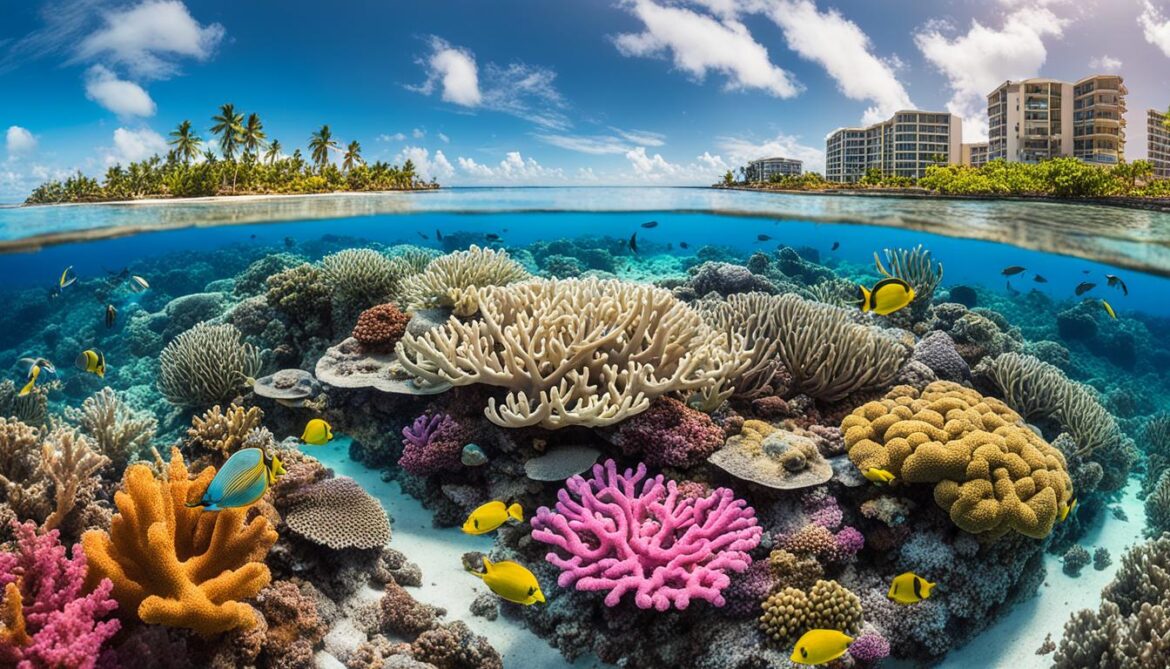
| Benefits of the National Biodiversity Strategy and Action Plan | Action Steps |
|---|---|
| 1. Conservation of biodiverse habitats and species | 1. Establish protected areas and implement management frameworks |
| 2. Protection of the marine environment | 2. Combat marine pollution and promote sustainable fishing practices |
| 3. Preservation of traditional culture and practices | 3. Integrate indigenous knowledge into biodiversity management strategies |
Conclusion
The Marshall Islands are home to a diverse and fragile biodiversity that is facing numerous threats. Invasive species and climate change pose significant challenges to the unique ecosystems of the islands. However, through collaborative conservation efforts led by the government, local communities, and organizations, there is hope for protecting and preserving the rich biodiversity of the Marshall Islands.
Sustainable development plays a crucial role in fostering biodiversity in the built environment. By incorporating green building practices and prioritizing habitat preservation, the Marshall Islands can strike a balance between urban development and ecological preservation. This approach ensures the long-term health and resilience of both the biodiversity and built environment of the islands.
The commitment to conservation and sustainable development in the Marshall Islands is vital for safeguarding the diverse species that call it home. By valuing and protecting its biodiversity, the Marshall Islands can create a sustainable future that benefits both the environment and its communities. The ongoing efforts to conserve and preserve the biodiversity of the Marshall Islands are crucial steps towards securing the health and prosperity of these unique and beautiful islands.




